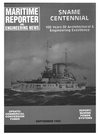
Page 58: of Maritime Reporter Magazine (September 1993)
Read this page in Pdf, Flash or Html5 edition of September 1993 Maritime Reporter Magazine
HYDRAULIC TOW PINS available with cable hold-down and stern roller mm3. « 30 YEARS
PROVEN QUALITY
SPARE PARTS
IN STOCK \Yi;STi:i?N AUCHIKi; WIIKKS 1870 HARBOUR ROAD, NORTH VANCOUVER, B.C. V7H 1A1 CANADA
TELEPHONE: (604) 929-7901 FAX: (604) 929-7951 OR 929-5329
Circle 337 on Reader Service Card
Circle 344 on Reader Service Card
Precision Navigation
Megapulse Accufix 500 N
B 5 W 3.3 3 an OE9 n o • 1 33 O.RB Bin OB H r^z
Accufix
Navigation Receivers
Selected by the United States Navy and the Royal Navy ^ Megapulse, Inc. 8 Preston Court Bedford, Mass. 01730-2380 USA (617)275-2010 Telex 92-3358 MEG-BDFD FAX (617) 275-4149
Circle 239 on Reader Service Card
CRUISE SHIP SAFETY
U.S.C.G. To Strengthen
Enforcement Of Cruise Ship
Safety Standards
Nearly all (137 out of 139) cruise ships oper-ating in U.S. ports are registered (or "flagged") with foreign countries. International safety standards for such ships are set through the International Maritime Organization (IMO), a United Nations agency. A ship's flag nation is responsible for certifying the ship's compliance with safety standards, although many nations delegate this task to classification societies, which perform safety inspections under con- tract. The country where the ship calls (the "port state") can conduct its own ship examinations to verify compliance with international standards and can detain a ship if it finds significant noncompliance. The Coast Guard performs these examinations and enforces standards in U.S. ports.
Through its safety examinations, the Coast
Guard continues to find safety problems on cruise ships, including inoperable fire doors and improperly designed escape routes. Key reasons for these problems include inadequate inspec- tions by flag nations or classification societies and differing interpretations of some key inter- national safety standards. IMO has begun ef- forts to identify needed reforms. However, the
Coast Guard has not adequately assessed infor- mation, nor shared it with IMO, on the extent of substandard safety oversight by flag nations and classification societies.
The Coast Guard's own examination program can be improved in two respects. First, the Coast
Guard needs to more effectively collect and analyze its cruise ship examination results, because its current automated system does not routinely track repeated deficiencies or detect deficiency trends by individual companies, flag nations, or classification societies. Second, the
Coast Guard needs to provide additional train- ing on international safety standards for its inspectors.
International standards contain limited train- ing requirements for crew members responsible for fighting shipboard fires. Since 1979 IMO has recommended, but not required, that fire squad members receive additional training in fighting shipboard fires.
Inspections by flag nations or surveys by classification societies are the primary check to ensure that international safety standards are met. However, the Coast Guard's port state examinations have identified instances in which flag nations or classification societies did not consistently identify or resolve problems that affect a ship's safety. For example, a Coast
Guard examination aboard a cruise ship in
October 1990 found inoperable fire doors and a possible leak in the hull, among other problems.
The ship had received a classification society's approval just six days before. Open-ended lan- guage in the standards results in some key safety requirements being left open to the flag nation's interpretation, such as the design of emergency escape routes.
The Coast Guard has held maritime work- shops and promoted initiatives at IMO tc strengthen flag nations' and classification soci eties' oversight. However, additional Coasi
Guard actions are needed to assist IMO ir strengthening certain flag nation inspectior requirements, such as the personnel and train ing needed to perform effective safety oversight
In the past Coast Guard inspectors receive! only one hour of formal training on interna tional safety standards. Inspectors said addi tional training would provide more consisten enforcement of safety standards. The Coas
Guard plans to add more training in 1993.
Fire investigations and routine Coast Guar examinations have both questioned crew men bers' ability to respond to shipboard fires. Fc example, the National Transportation Safel
Board has issued six reports on foreign cruis ship fires since 1980, five of which conclude that the incidents were marked by poor crew fi] fighting, ineffective responses, or both. Undi current international standards, most crew a signed to fire squads are not required to recer training other than to participate in period drills and shipboard instruction. Repeated Coa
Guard examinations suggest that these dril and instruction have not been sufficient, t cause fire squad members were repeatedly inc pable of performing satisfactory fire drills. Cr« members who are required to receive forn training are not required to update it, ev though shipboard fire fighting techniques ha changed in recent years.
Between 1979 and 1990 IMO adopted a ser of nonmandatory recommendations calling additional formal training courses and cert cations of proficiency. Eight companies review had all taken some steps that exceed IMO quirements, but only one had implemented of the recommendations.
International standards do not ensure t] emergency information to assist in passen evacuation in clear and readily available. En gency symbols and terms were often uncl< emergency information presented in passen cabins was not always adequate, and effecl escape route diagrams were not routinely us
For example, none of the eight companies ] vided emergency diagrams in dining halls lounges showing the passengers' locatior relation to emergency stations or showing n than one route of escape to such stations.
A Coast Guard group has considered a : "system" approach to emergency escape by dressing several related safety standards eluding those on emergency information, de of escape routes, and emergency lighting, single proposal. However, the Coast Guard not decided whether to submit this approa(
IMO, because it has not yet obtained inte consensus on key elements. 60 Maritime Reporter/Engineering News

 57
57

 59
59
